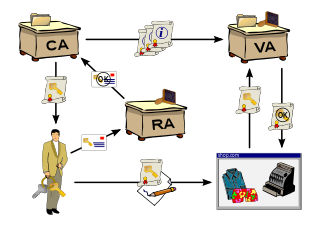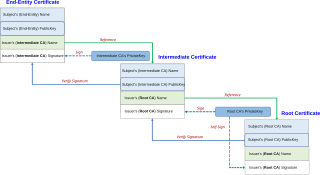X.500 is a series of computer networking standards covering electronic directory services. The X.500 series was developed by the Telecommunication Standardization Sector of the International Telecommunication Union (ITU-T). ITU-T was formerly known as the Consultative Committee for International Telephony and Telegraphy (CCITT). X.500 was first approved in 1988. The directory services were developed to support requirements of X.400 electronic mail exchange and name lookup. The International Organization for Standardization (ISO) and International Electrotechnical Commission (IEC) were partners in developing the standards, incorporating them into the Open Systems Interconnection suite of protocols. ISO/IEC 9594 is the corresponding ISO/IEC identification.

A public key infrastructure (PKI) is a set of roles, policies, hardware, software and procedures needed to create, manage, distribute, use, store and revoke digital certificates and manage public-key encryption.
In cryptography, a public key certificate, also known as a digital certificate or identity certificate, is an electronic document used to prove the validity of a public key. The certificate includes the public key and information about it, information about the identity of its owner, and the digital signature of an entity that has verified the certificate's contents. If the device examining the certificate trusts the issuer and finds the signature to be a valid signature of that issuer, then it can use the included public key to communicate securely with the certificate's subject. In email encryption, code signing, and e-signature systems, a certificate's subject is typically a person or organization. However, in Transport Layer Security (TLS) a certificate's subject is typically a computer or other device, though TLS certificates may identify organizations or individuals in addition to their core role in identifying devices. TLS, sometimes called by its older name Secure Sockets Layer (SSL), is notable for being a part of HTTPS, a protocol for securely browsing the web.
In cryptography, X.509 is an International Telecommunication Union (ITU) standard defining the format of public key certificates. X.509 certificates are used in many Internet protocols, including TLS/SSL, which is the basis for HTTPS, the secure protocol for browsing the web. They are also used in offline applications, like electronic signatures.

In cryptography and computer security, a root certificate is a public key certificate that identifies a root certificate authority (CA). Root certificates are self-signed and form the basis of an X.509-based public key infrastructure (PKI). Either it has matched Authority Key Identifier with Subject Key Identifier, in some cases there is no Authority Key identifier, then Issuer string should match with Subject string. For instance, the PKIs supporting HTTPS for secure web browsing and electronic signature schemes depend on a set of root certificates.
In cryptography, a certificate authority or certification authority (CA) is an entity that stores, signs, and issues digital certificates. A digital certificate certifies the ownership of a public key by the named subject of the certificate. This allows others to rely upon signatures or on assertions made about the private key that corresponds to the certified public key. A CA acts as a trusted third party—trusted both by the subject (owner) of the certificate and by the party relying upon the certificate. The format of these certificates is specified by the X.509 or EMV standard.

Gen Digital Inc. is a multinational software company co-headquartered in Tempe, Arizona and Prague, Czech Republic. The company provides cybersecurity software and services. Gen is a Fortune 500 company and a member of the S&P 500 stock-market index. The company also has development centers in Pune, Chennai and Bangalore. Its portfolio includes Norton, Avast, LifeLock, Avira, AVG, ReputationDefender, and CCleaner.

Key exchange is a method in cryptography by which cryptographic keys are exchanged between two parties, allowing use of a cryptographic algorithm.
In cryptography and computer security, self-signed certificates are public key certificates that are not issued by a certificate authority (CA). These self-signed certificates are easy to make and do not cost money. However, they do not provide any trust value.
Thawte Consulting is a certificate authority (CA) for X.509 certificates. Thawte was founded in 1995 by Mark Shuttleworth in South Africa. As of December 30, 2016, its then-parent company, Symantec Group, was collectively the third largest public CA on the Internet with 17.2% market share.
Xcitium, formerly known as Comodo Security Solutions, Inc., is a cybersecurity company headquartered in Bloomfield, New Jersey.
GeoTrust is a digital certificate provider. The GeoTrust brand was bought by Symantec from Verisign in 2010, but agreed to sell the certificate business in August 2017 to private equity and growth capital firm Thoma Bravo LLC. GeoTrust was the first certificate authority to use the domain-validated certificate method which accounts for 70 percent of all SSL certificates on the Internet. By 2006, GeoTrust was the 2nd largest certificate authority in the world with 26.7 percent market share according to independent survey company Netcraft.

DigiCert, Inc. is a digital security company headquartered in Lehi, Utah. DigiCert provides public key infrastructure (PKI) and validation required for issuing digital certificates or TLS/SSL certificates, acting as a certificate authority (CA) and trusted third party.
The Certification Authority Browser Forum, also known as the CA/Browser Forum, is a voluntary consortium of certification authorities, vendors of Internet browser and secure email software, operating systems, and other PKI-enabled applications that promulgates industry guidelines governing the issuance and management of X.509 v.3 digital certificates that chain to a trust anchor embedded in such applications. Its guidelines cover certificates used for the SSL/TLS protocol and code signing, as well as system and network security of certificate authorities.
StartCom was a certificate authority founded in Eilat, Israel, and later based in Beijing, China, that had three main activities: StartCom Enterprise Linux, StartSSL and MediaHost. StartCom set up branch offices in China, Hong Kong, the United Kingdom and Spain. Due to multiple faults on the company's end, all StartCom certificates were removed from Mozilla Firefox in October 2016 and Google Chrome in March 2017, including certificates previously issued, with similar removals from other browsers expected to follow.
DigiNotar was a Dutch certificate authority owned by VASCO Data Security International, Inc.

The Certificate Authority Security Council (CASC) is a multi-vendor industry advocacy group created to conduct research, promote Internet security standards and educate the public on Internet security issues.
Let's Encrypt is a non-profit certificate authority run by Internet Security Research Group (ISRG) that provides X.509 certificates for Transport Layer Security (TLS) encryption at no charge. It is the world's largest certificate authority, used by more than 300 million websites, with the goal of all websites being secure and using HTTPS. The Internet Security Research Group (ISRG), the provider of the service, is a public benefit organization. Major sponsors include the Electronic Frontier Foundation (EFF), the Mozilla Foundation, OVH, Cisco Systems, Facebook, Google Chrome, Internet Society, AWS, NGINX, and Bill and Melinda Gates Foundation. Other partners include the certificate authority IdenTrust, the University of Michigan (U-M), and the Linux Foundation.
Trustico is a dedicated SSL certificate provider, They are headquartered in the United Kingdom.
In 2015, the government of Kazakhstan created a root certificate which could have enabled a man-in-the-middle attack on HTTPS traffic from Internet users in Kazakhstan. The government described it as a "national security certificate". If installed on users' devices, the certificate would have allowed the Kazakh government to intercept, decrypt, and re-encrypt any traffic passing through systems it controlled.






